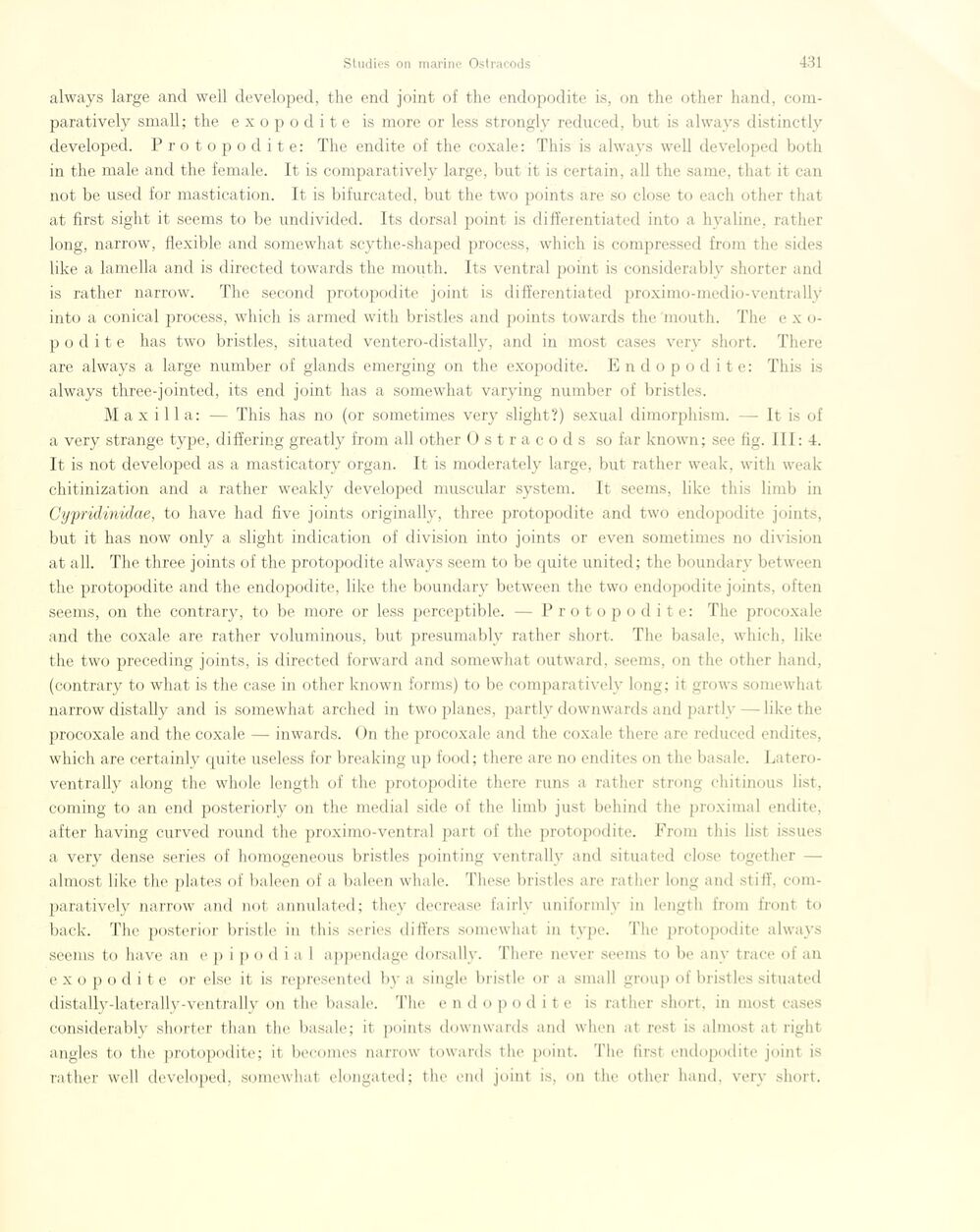
Full resolution (JPEG) - On this page / på denna sida - Sidor ...

<< prev. page << föreg. sida << >> nästa sida >> next page >>
Below is the raw OCR text
from the above scanned image.
Do you see an error? Proofread the page now!
Här nedan syns maskintolkade texten från faksimilbilden ovan.
Ser du något fel? Korrekturläs sidan nu!
This page has never been proofread. / Denna sida har aldrig korrekturlästs.
always large and well developed, the end joint of the endopodite is, on the other hånd,
com-paratively small; the exopodite is more or less strongly reduced, but is always distinctly
developed. Protopodite: The endite of the coxale: This is always well developed botli
in the male and the female. It is comparatively large, but it is certain, all the same, that it can
not be used for mastication. It is bifurcated, but the two points are so close to each other that
at first sight it seems to be undivided. Its dorsal point is differentiated into a hyaline, rather
long, narrow, flexible and somewhat scythe-shaped process, which is compressed from the sides
like a lamella and is directed towards the mouth. Its ventral point is considerably shorter and
is rather narrow. The second protopodite joint is differentiated proximo-medio-ventrally
into a conical process, which is armed witli bristles and points towards the ’mouth. The e x
o-p o d i t e has two bristles, situated ventero-distally, and in most cases very short. There
are always a large number of glands emerging on the exopodite. Endopodite: This is
always three-jointed, its end joint has a somewhat varying number of bristles.
Maxilla: — This has no (or sometimes very slight?) sexual dimorphism. — It is of
a very strange type, differing greatly from all other Ostraeods so far known; see fig. III: 4.
It is not developed as a masticatory organ. It is moderately large, but rather weak, witli weak
chitinization and a rather weakly developed muscular system. It seeins, like this limb in
Cypridinidae, to have had five joints originally, three protopodite and two endopodite joints,
but it has now only a slight indication of division into joints or even sometimes no division
at all. The three joints of the protopodite always seem to be quite united; the boundarv between
the protopodite and the endopodite, like the boundary between the two endopodite joints, often
seems, on the contrary, to be more or less perceptible. — Protopodite: The procoxale
and the coxale are rather voluminous, but presumably rather short. The basale, which, like
the two preceding joints, is directed forward and somewhat outward, seems, on the other hånd,
(contrary to what is the case in other known forms) to be comparatively long; it grows somewhat
narrow distally and is somewhat arched in two planes, partly downwards and partly—like the
procoxale and the coxale — inwards. On the procoxale and the coxale there are reduced endites,
which are certainly quite useless for breaking up food; there are no endites on the basale.
Latero-ventrally along the whole length of the protopodite there runs a rather strong chitinous list,
coming to an end posteriorly on the media! side of the limb just behind the proximal endite,
after having curved round the proximo-ventral part of the protopodite. From this list issues
a very dense series of homogeneous bristles pointing ventrally and situated close together
-almost like the plates of baleen of a baleen whale. These bristles are rather long and stiff.
comparatively narrow and not annulated; they decrease fairlv uniformlv in length from front to
back. The posterior bristle in this series differs somewhat in type. The protopodite always
seems to have an e p i p o d i a 1 appendage dorsally. There never seems to be any trace of an
exopodite or else it is represented by a single bristle or a small group of bristles situated
distally-laterally-ventrally on the basale. The e n d o p o d i t e is rather short, in most cases
considerably shorter than the basale; it points downwards and when at rest is almost at right
angles to the protopodite; it becomes narrow towards the point. The first endopodite joint is
rather well developed, somewhat elongated; the end joint is, on the other hånd, very short.
<< prev. page << föreg. sida << >> nästa sida >> next page >>